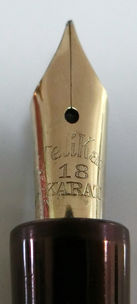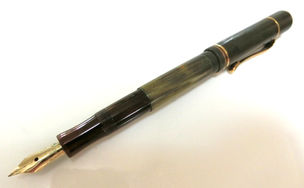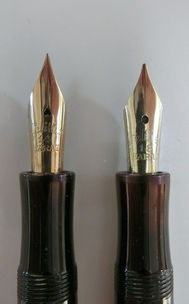top of page
Pelikan fountain pen (ca.1930) - the second generation
Green indicates the changes from Pelikan fountain pen (ca.1929).
Cap top; material: ebonite, shape: cylindrical, plane cap top edge, logo: old four chicks logo on the top, "Pelikan PATENT Pelikan PATENT" on the lateral side.
Cap tube; material: ebonite, shape: 4 vent holes (two holes facing each other), two gold plated narrow bands.
Clip; shape: gold plated drop clip (narrower than 1st generation).
Nib; material: 18 ct gold, shape: round vent hole, logo:
Pelikan
18
KARAT
Feed; material: ebonite, shape: slanted tail, three lamellae with the recess.
Nib socket; material: ebonite. shape: long (17 mm).
Grip section and barrel; material: one piece transparent bakelite, shape: plane top edge, plane side edge, concave grip section.
Sleeve; material: celluloid.
Filling system; material: ebonite with cork seal, shape: knurled turning knob with arrow.
Dimensions;
In November, 1930, Günter Wagner made the first changes to the model (Pelikan-collectibles)⁽¹⁾.
-
Vent hole of the nib was changed to round shape (Fig.4)⁽²⁾.
-
Cap rings were added to the cap tube⁽³⁾.
-
Vent holes were added to the cap tube⁽¹⁾.
The inner wall of the cap was regularly stained with ink while opening and closing it. Without ventilation, condensed ink would stain the grip section. So the additional vent holes were introduced to keep dry the room between the inner wall and the grip section (Pelikan Schreibgeräte)(Fig.5). Additional vent holes were located 6 mm under the existing ones. The cap sealing system itself was same as the first generation.
-
The new sleeve color "olive green" was added⁽⁴⁾.
In the same year, the new model and variations of Pelikan fountain pen were introduced.
-
The new model with 14 ct gold sleeve/cap rings was introduced. It was named "Pelikan Gold" (model number system was not yet introduced at that time. Later, the model was renamed Pelikan 111) (Pelikan official site).
-
18 ct gold nib was introduced as the export model for the French market⁽⁵⁾(Fig.1). In the French market, only 18 ct gold nibs can be referred as gold nibs. The export models for other regions had 14 ct gold nibs.
-
The ring without clip section was offered as an option. The ring was to replace the original clip. The pen without clip was designed for ladies who carry it in their handbag.
Note;⁽¹⁾Please note that some changes were made at different time points, not once. So, in addition to variations as stated above, there were several transitional models. Actually, the model with 2 cap holes (one hole facing each other) and 2 cap rings exists (Pelikan Schreibgeräte). According to GoPens, additional vent holes were made in early 1931. If this is the case with my pen, it would be dated in 1931. Of curse, the notion of "generation" did not exist at that time, Günter Wagner would never think of them as transitional models.
⁽²⁾The reason for the change remains to be elucidated.
⁽³⁾The cap rings of the time were intended to decorate the pen rather than protect the cap lip (Pelikan Schreibgeräte). Montblanc introduced the cap rings in 1927 and Günter Wagner did so a few years later (1930) to suit the consumers’ taste. "Bauhaus designs feature little ornamentation and a focus on balanced forms and abstract shapes... The only piece of gilding is a clip which marries the essence of form and function. Ornamentation by way of the addition of gold plated cap rings wouldn’t come until roughly a year later, presumably after the look of the pen was deemed to be a bit too austere (Pelikan’s Perch)". The two tiny rings, are positioned almost in the middle of the pen when the cap is posted, which give me the impression that the pen is refined and well-balanced. By the way, when the cap is posted, what holds the cap is the cone, not the turning knob, and if securely capped, the edge of the cone comes just under the lower cap ring (Fig.6). This suggests that cap rings was only an ornament but also serve to protect the cap from being damaged by the cone. If so, cap rings are the essence of form and function, too.
⁽⁴⁾The first generation had jade green sleeve. The early green sleeves can be lumped into three types (Pelikan Pens: History, Pelikan-collectibles). In the order of introduction:
-
Jade green (1929-1933). "Much less common early jade, which looks like the Sheaffer green."
-
Olive green (1930-1931). "Made from cut strips of celluloid laminated together (Fig.6)."
-
Marble green (1931-1944). "The familiar marbled green (marmoriert)". Introduced in the third generation.
⁽⁵⁾That indicates that Günter Wagner started to export Pelikan fountain pens as early as 1930.
bottom of page






